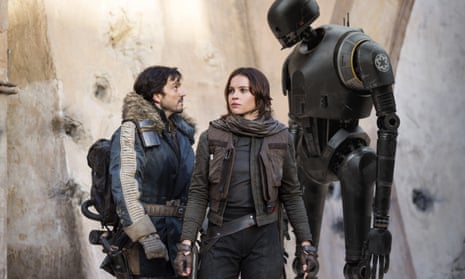With a fortnight still to go before its release, Rogue One is nonetheless set to be 2016’s highest-grossing film. The first “anthology” movie in the Star Wars franchise, it is set in roughly the same universe as episodes one to seven, but features none of the familiar characters. Its cast is more credible than A-list: Felicity Jones, Ben Mendelsohn, Riz Ahmed, Diego Luna. Likewise, its British director, Gareth Edwards.
Yet such is the strength of George Lucas’s space saga brand, acquired by Disney for $4.05bn in 2012, that earlier this week, Rogue One broke presale ticket records for the year. Pundits predict a final global total of $1.4bn.
But these figures may mask a slightly different story. Although three films (Finding Dory, Captain America: Civil War and Zootropolis) have already tipped the billion dollar mark in 2016, the market is perceived to be down, making topping the charts less of a challenge. And although impressive, Rogue One’s presales pale in comparison to those for last December’s Star Wars: A Force Awakens, which went on to make $2.1bn.
Rumbling concerns around the film began in August, with word that Edwards had taken a backseat while co-writer Tony Gilroy reshot, according to some quotes, around 40% of the film. Insiders insisted Gilroy’s role was mostly in post-production, yet on Wednesday it was reported that his fee had risen from around $200,000 to more than $5m, fuelling further speculation that Disney’s issues with the original cut had been considerable.
“It does sound a little bit unusual,” says Bruce Nash, founder and publisher of box office analysis site The Numbers. While rival studio Marvel now builds two weeks of reshoots into its schedule as standard, and successful blockbusters such as Titanic and Back to the Future were changed considerably, these changes are generally to address casting concerns or redo an ending, rather than something as fundamental as the director.
But the real reason may not be so straightforward as the studio being keen to improve a movie in which they had already invested $200m. For while Disney would naturally seek to maximise profits on the film, it would not do so at the expense of its core product: the Skywalker saga. “It’s an interesting decision for Disney,” says Nash. “They want to reinforce the franchise, and they probably don’t want to cloud the waters.”
Earlier this week, Edwards confirmed that Rogue One will not have the iconic opening text “crawl” so synonymous with the series, while producer Kathleen Kennedy vowed that regardless of Rogue One’s success, no sequel would be forthcoming. Its function, then, is as much to keep the series in public consciousness and maintain momentum for next Christmas’s Episode VIII as it is to stand on its own feet.
“Disney would have been looking at the film through two lenses,” says Nash. “How do we make a great film and how do we fit it into the overall mythology? They want the secondary films [a young-Han-Solo movie is also on the way] to build into making the next main story even more interesting.”
It’s possible that Edwards, the man behind highly innovative sci-fi film Monsters, might in fact have made a movie so interesting it was actively distracting. Gilroy won acclaim for the George Clooney drama Michael Clayton, but his last film was the more generic The Bourne Legacy, whose tone may be more in keeping with what Disney desire.
It’s momentum, too: while The Bourne Legacy took a healthy profit, it didn’t make as much as the previous films, nor was it so critically successful as to steer the series down a path in which Jeremy Renner became the lead rather than Matt Damon.
So the current box-office predictions for the film – mammoth yet not mould-breaking – could be good news for the studio. It may also have been cheered by the numbers for Warner Bros’s Fantastic Beasts and Where to Find Them: another series spun off from a beloved franchise. In the US, that film opened with just half of what the final Harry Potter film made – a ratio that would likely suit Disney.
Rogue One’s final total will depend on its level of mainstream cut-through. Says Nash: “Episode VII was a huge family gathering. I don’t feel that’s the case for Rogue One. Core movie fans are going to go out in droves but in order to hit the real heights you have to answer yes to the question: is grandma going to come see this film?”
Making an event movie is great in theory. But you don’t want it to upstage the main event.

Comments (…)
Sign in or create your Guardian account to join the discussion